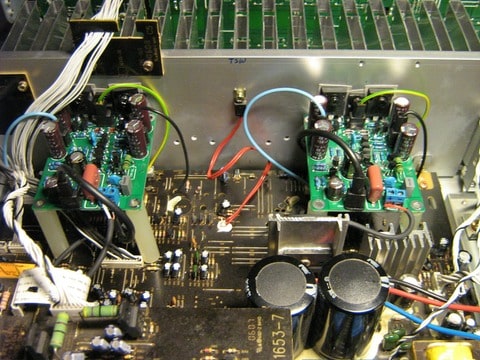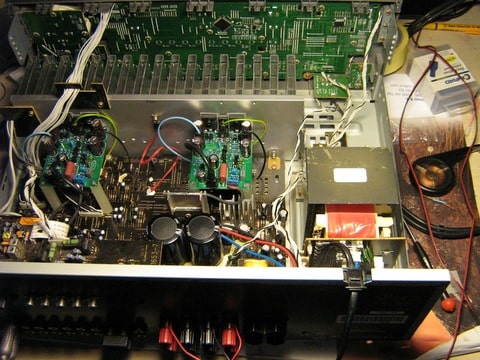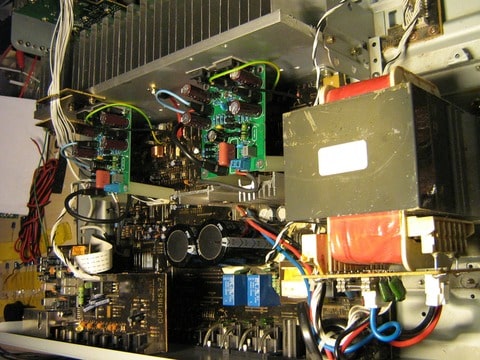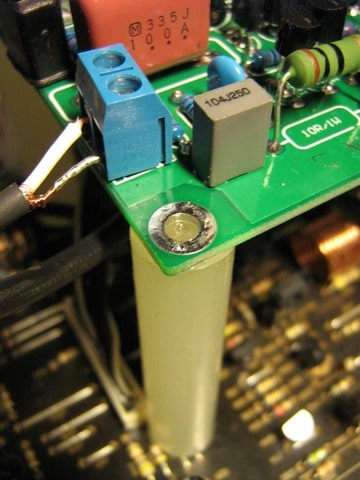Hello ljm, its nice to see your well known amplifier in a even smaller SMD version. Can you tell us something about the difference in performance compared to the non SMD version?
I could read in a description: Frequency Response: 20HZ-35K HZ + -3DB.
I have measured the 15D where the upper frequency was about 22K, so does it mean the output filter has changed?
I could read in a description: Frequency Response: 20HZ-35K HZ + -3DB.
I have measured the 15D where the upper frequency was about 22K, so does it mean the output filter has changed?
I found another version of your L15D on ebay, the L15D-PS here:
Link.
This interests me as I only need to buy a toroidal transformer!
If I want to use 2 (for two subwoofers), is a 40 V, 600 VA transformer ok? Like this:
TST600/014 INDEL - Transformer: toroidal | TME - Electronic components
The subwoofers are sealed L26ROY (max 250 W continous) and they are about 2.5 m apart. Is it best to have long speaker cables or long power cables from transformer to L15D-PS?
/Anton
Link.
This interests me as I only need to buy a toroidal transformer!
If I want to use 2 (for two subwoofers), is a 40 V, 600 VA transformer ok? Like this:
TST600/014 INDEL - Transformer: toroidal | TME - Electronic components
The subwoofers are sealed L26ROY (max 250 W continous) and they are about 2.5 m apart. Is it best to have long speaker cables or long power cables from transformer to L15D-PS?
/Anton
Nice Casing huh?
I just built the L7 into a Harman Kardon HK3480 that had a severely busted amplifier part. Nice to have something looking as nice as this with a diy amp inside. The remote control is also very welcome!
I added some pictures below.
Sound: in the beginning sound was ok, but there was no air in the sound. No with a couple of playing hours it starts to improve, so lets see how it will be after more hours of playing.




The prints are mounted on the heatsink and supported by glue sticks
I just built the L7 into a Harman Kardon HK3480 that had a severely busted amplifier part. Nice to have something looking as nice as this with a diy amp inside. The remote control is also very welcome!
I added some pictures below.
Sound: in the beginning sound was ok, but there was no air in the sound. No with a couple of playing hours it starts to improve, so lets see how it will be after more hours of playing.




The prints are mounted on the heatsink and supported by glue sticks
Hi Anton,
very interesting, there are some other IRS2092 based amps I have not seen before. For example this L20D is a version that has new capacitors installed:
L20D 200 250W 2 8ohm Stereo Class D IRAUDAMP7 IRS2092 IRFI4020 Completed Board | eBay
and here is a amp called L30D:
L30D 300 850W Mono Digital Amplifier IRS2092 IRFB4227 IRAUDAMP9 | eBay
It should be an easy way to build an amp with the boards you have found, because you need only to connect a transformer and speaker protection is also included.
Regarding cabling I would prefer a longer power cable. But if you use for example 1,5 or 2,5 mm wires for the loudspeakers I don't think you would have problems. But this is just my opinion and I don't want to start a discussion about the influence and sound of cables.
A Transformer with 2 X 40V should be fine, and will give about 56V on the capacitors. 300 or 400 Watt Transformers should be enough but if space and wight is no problem you can use 600W Transformers.
By the way I have also the L26ROY's at home and will build 3 way loudspeakers controlled by Class D amplifiers.
very interesting, there are some other IRS2092 based amps I have not seen before. For example this L20D is a version that has new capacitors installed:
L20D 200 250W 2 8ohm Stereo Class D IRAUDAMP7 IRS2092 IRFI4020 Completed Board | eBay
and here is a amp called L30D:
L30D 300 850W Mono Digital Amplifier IRS2092 IRFB4227 IRAUDAMP9 | eBay
It should be an easy way to build an amp with the boards you have found, because you need only to connect a transformer and speaker protection is also included.
Regarding cabling I would prefer a longer power cable. But if you use for example 1,5 or 2,5 mm wires for the loudspeakers I don't think you would have problems. But this is just my opinion and I don't want to start a discussion about the influence and sound of cables.
A Transformer with 2 X 40V should be fine, and will give about 56V on the capacitors. 300 or 400 Watt Transformers should be enough but if space and wight is no problem you can use 600W Transformers.
By the way I have also the L26ROY's at home and will build 3 way loudspeakers controlled by Class D amplifiers.
I used this link for an english version of the store but there is nothing in 'products'.
LJM AUDIO DIY - Small Orders Online Store, Hot Selling and more on Aliexpress.com | Alibaba Group
LJM AUDIO DIY - Small Orders Online Store, Hot Selling and more on Aliexpress.com | Alibaba Group
To be clear: The two you are linking to requires more than just transformer though.Hi Anton,
very interesting, there are some other IRS2092 based amps I have not seen before. For example this L20D is a version that has new capacitors installed:
L20D 200 250W 2 8ohm Stereo Class D IRAUDAMP7 IRS2092 IRFI4020 Completed Board | eBay
and here is a amp called L30D:
L30D 300 850W Mono Digital Amplifier IRS2092 IRFB4227 IRAUDAMP9 | eBay
It should be an easy way to build an amp with the boards you have found, because you need only to connect a transformer and speaker protection is also included.
Regarding cabling I would prefer a longer power cable. But if you use for example 1,5 or 2,5 mm wires for the loudspeakers I don't think you would have problems. But this is just my opinion and I don't want to start a discussion about the influence and sound of cables.
A Transformer with 2 X 40V should be fine, and will give about 56V on the capacitors. 300 or 400 Watt Transformers should be enough but if space and wight is no problem you can use 600W Transformers.
By the way I have also the L26ROY's at home and will build 3 way loudspeakers controlled by Class D amplifiers.
300 or 400 Watt per amplifier board? Or in total? I'll use two boards to power the two subwoofers (one in each end):

In the middle compartment I'm keeping the nanoAVR HDA and would therefore put the transformer there as well. The question is then if it is preferable to have the L15D-PS modules as close to the subwoofers as possible (with long power cable and long signal cable) or to keep them close to the transformer (with long speaker cables). I'm leaning towards long speaker cables as they have a larger signal and should therefore be affected less. The signal cable is however shielded (RCA), but still...
/Anton
Hi Anton,
I have posted the links just because there are new versions of IRS2092 boards. The board you have posted is for sure the one that needs less effort to build a complete amplifier.
I did understand that you want to use two 600W transformers that is not necessary because one would be enough for two channels. If you want to use one transformer for each channel than 300W are enough.
For the configuration you describe I would also place the L15D close to the Transformer, use a short signal cable and longer cables for the speakers.
But I am sure many people use long signal cables for their subwoofer amplifiers without problems because only a limited bandwidth is required, so all noise above 200 Hz or below can be filtered out.
I have posted the links just because there are new versions of IRS2092 boards. The board you have posted is for sure the one that needs less effort to build a complete amplifier.
I did understand that you want to use two 600W transformers that is not necessary because one would be enough for two channels. If you want to use one transformer for each channel than 300W are enough.
For the configuration you describe I would also place the L15D close to the Transformer, use a short signal cable and longer cables for the speakers.
But I am sure many people use long signal cables for their subwoofer amplifiers without problems because only a limited bandwidth is required, so all noise above 200 Hz or below can be filtered out.
Just as additional information, there is also a version 2 of the L15D with other capacitors:
Assembled L15D LMJ 2.0 Channel Class D Audio Power Amplifier IRS2092+IRF14019H
Assembled L15D LMJ 2.0 Channel Class D Audio Power Amplifier IRS2092+IRF14019H
Hello,
I have also heard this amp and has a good sound.
I want to put a protection circuit for the speakers, as if crossed or cortorcircuita any of the output transistors, the speakers may be damaged.
I thought of using a special integrated circuit for this purpose is the UPC 1237h. The circuit has a short delay. During this short time the amplifier is not connected load at its output.
This may be dangerous to the integrity of the amplifier?
A salute to the forum
I have also heard this amp and has a good sound.
I want to put a protection circuit for the speakers, as if crossed or cortorcircuita any of the output transistors, the speakers may be damaged.
I thought of using a special integrated circuit for this purpose is the UPC 1237h. The circuit has a short delay. During this short time the amplifier is not connected load at its output.
This may be dangerous to the integrity of the amplifier?
A salute to the forum
I am considering to use the L15D-PS Assembled L15D PS Ver Amplifier Board 300W Mono MOSFET IRFB4019 Amp | eBay (With rectifier and IRBF4019) and I wonder if I could use an existing AC transformer.
The Transformer I have has dual output of +-43 volt AC measured. Is this too much for the L15D ? I see that it is specified to +-40 volt AC max.
I am going to drive a Peerless XLS-12 830500 with Zn=8 ohm Re=3.5 ohm as a subwoofer.
Will it be possible to drive the subwoofer with a L15D or is it underpowered and can it handle enough current to be able to control the Peerless?
The Transformer I have has dual output of +-43 volt AC measured. Is this too much for the L15D ? I see that it is specified to +-40 volt AC max.
I am going to drive a Peerless XLS-12 830500 with Zn=8 ohm Re=3.5 ohm as a subwoofer.
Will it be possible to drive the subwoofer with a L15D or is it underpowered and can it handle enough current to be able to control the Peerless?
I am considering to use the L15D-PS Assembled L15D PS Ver Amplifier Board 300W Mono MOSFET IRFB4019 Amp | eBay (With rectifier and IRBF4019) and I wonder if I could use an existing AC transformer.
The Transformer I have has dual output of +-43 volt AC measured. Is this too much for the L15D ? I see that it is specified to +-40 volt AC max.
I am going to drive a Peerless XLS-12 830500 with Zn=8 ohm Re=3.5 ohm as a subwoofer.
Will it be possible to drive the subwoofer with a L15D or is it underpowered and can it handle enough current to be able to control the Peerless?
That's just over 60v. It would work, but taking into account the fact that your mains voltage varies and can push you way over 60v at times, it likely wouldn't be long before your blew something. 60v should get you sufficient power into 8Ohms much more reliably with something like the L25d
I have also looked at the L25D and it has more power as specified, but my main concern is the lesser ability for the L25D to handle lower impedance. The Peerless XLS is a 8 ohm driver but is in some frequencies as low as 3.5 ohm.
Some people also warn about the bus pumping when driving a subwoofer with these class-d amps.
Some people also warn about the bus pumping when driving a subwoofer with these class-d amps.
I suppose you should verify this with ljm or others but believe the L25D will be fine with that driver. Looking at the impedance graph for this driver model-830500.pdf, the impedance is lowest between 100-150Hz and rises from there. If you have enough capacitance, (20,000uf/rail should be more than enough) bus pumping shouldn't be an issue.
Re-bump my Q about the voltage of the capacitors ...
and to say, that the L15D Pro is an excellent amp even without the OS-CON caps i have been running it for the last month or so non-stop and it has surprised me more than once with its capacity to reveal subtleties in the music that I hadn't been aware of before ;-) I'm getting great bass as well as opposed to some other comments I have read here.
i have been running it for the last month or so non-stop and it has surprised me more than once with its capacity to reveal subtleties in the music that I hadn't been aware of before ;-) I'm getting great bass as well as opposed to some other comments I have read here.
and to say, that the L15D Pro is an excellent amp even without the OS-CON caps
www.irf.com/product-info/datasheets/data/irfi4019h-117p.pdf
The IRFI4019 is rated at 150V max, so no more than 135V (±67.5V) to be safe.
30A peak, 8.7A RMS (25°C), 6.2A RMS (100°C).
The IRFI4019 is rated at 150V max, so no more than 135V (±67.5V) to be safe.
30A peak, 8.7A RMS (25°C), 6.2A RMS (100°C).
If LJM or anyone with knowledge of this amp is reading this, I would like to know if I can operate the amp from +/- 53V rails (regulated, switching PS) into 8 ohms. The specs show as an example +/-50V rails into 8R, but don't give any limits on the rail voltages.
Is +/-53V OK?
Is +/-53V OK?
If LJM or anyone with knowledge of this amp is reading this, I would like to know if I can operate the amp from +/- 53V rails (regulated, switching PS) into 8 ohms. The specs show as an example +/-50V rails into 8R, but don't give any limits on the rail voltages.
Is +/-53V OK?
After re-reading this thread I see he tested it using +/- 54v (See first few posts).
- Home
- Vendor's Bazaar
- LJM Audio